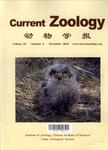Interspecific competition, hybridization, and reproductive isolation in secondary contact: missing perspectives on males and females
Interspecific competition, hybridization, and reproductive isolation in secondary contact: missing perspectives on males and females作者机构:Department of Ecology and Evolutionary Biology Division of Biology University of Tennessee KnoxvilleTennessee 37996 USA
出 版 物:《Current Zoology》 (动物学报(英文版))
年 卷 期:2018年第64卷第1期
页 面:75-88页
核心收录:
学科分类:0710[理学-生物学] 07[理学] 08[工学] 0836[工学-生物工程] 071002[理学-动物学]
基 金:S.E.L. was supported by a National Science Foundation (NSF) Graduate Research Opportunities Worldwide (GROW) Fellowship in Switzerland and NSF Graduate Research Fellowship under Grant No. 1154145. Any opinion findings and conclusions or recommendations expressed in this material are those of the author and do not necessarily reflect the views of the NSF
主 题:female-female competition hybridization male-male competition reproductive isolation sexual selection
摘 要:Research on sexual selection and hybridization has focused on female mate choice and male-male competition. While the evolutionary outcomes of interspecific female preference have been well explored, we are now gaining a better understanding of the processes by which male-male compe- tition between species in secondary contact promotes reproductive isolation versus hybridization. What is relatively unexplored is the interaction between female choice and male competition, as they can oppose one another or align with similar outcomes for reproductive isolation. The role of female-female competition in hybridization is also not well understood, but could operate similarly to male-male competition in polyandrous and other systems where costs to heterospecific mating are low for females. Reproductive competition between either sex of sympatric species can cause the divergence and/or convergence of sexual signals and recognition, which in turn influences the likelihood for interspecific mating. Future work on species interactions in secondary contact should test the relative influences of both mate choice and competition for mates on hybridization outcomes, and should not ignore the possibilities that females can compete over mating resources, and males can exercise mate choice.



